APIC Branch Network
VerifiedAdded on 2023/01/20
|15
|2655
|72
AI Summary
The objective of this report is about representing the geographical expanse of the overall network of APIC or Asia Pacific International College as also detailing logical and physical design of their recently established Sydney branch while also talking about computing and associated virtualization techniques.
Contribute Materials
Your contribution can guide someone’s learning journey. Share your
documents today.

Running head: APIC BRANCH NETWORK
APIC Branch Network
Name of the Student
Name of the University
Author Note
APIC Branch Network
Name of the Student
Name of the University
Author Note
Secure Best Marks with AI Grader
Need help grading? Try our AI Grader for instant feedback on your assignments.
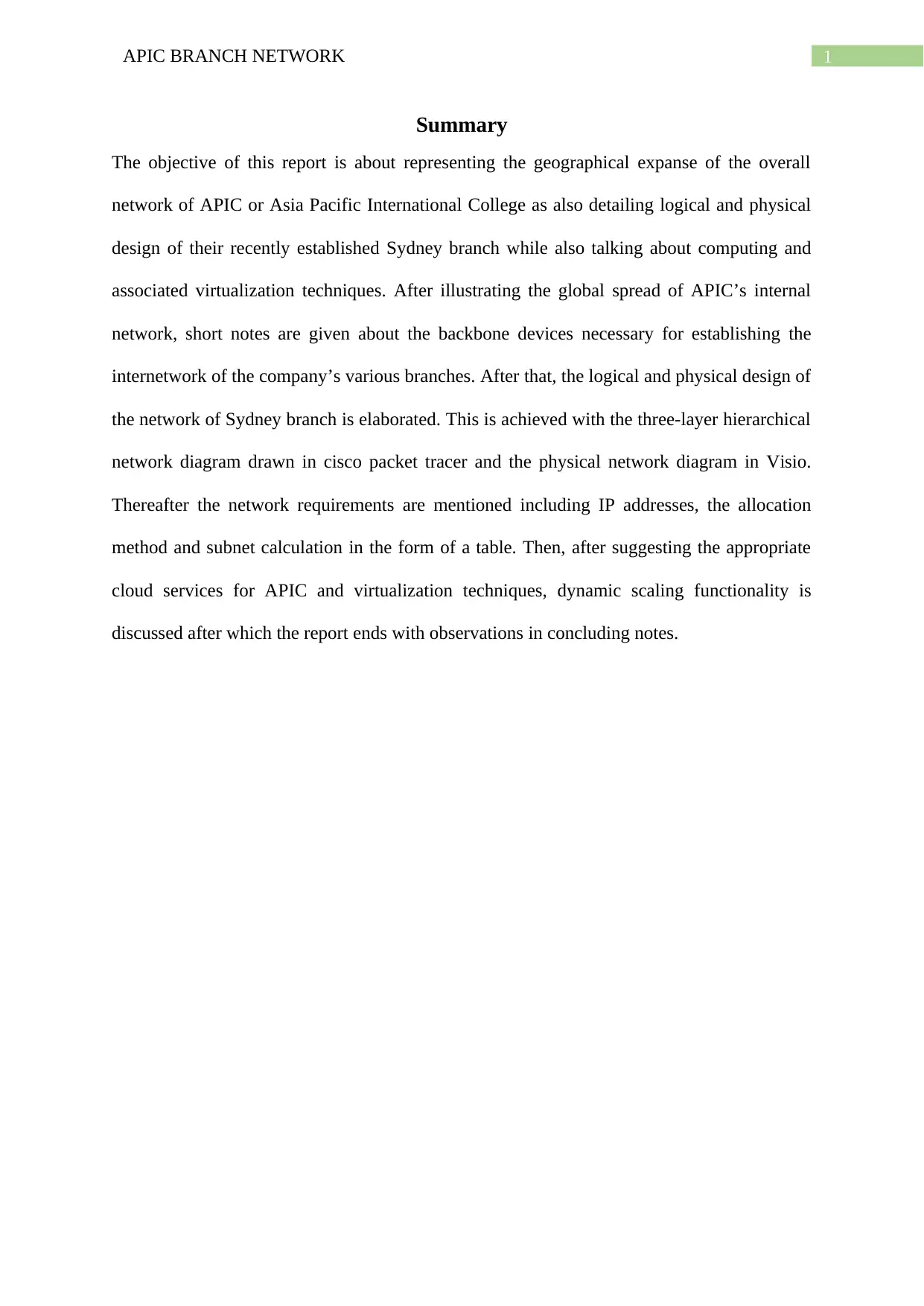
1APIC BRANCH NETWORK
Summary
The objective of this report is about representing the geographical expanse of the overall
network of APIC or Asia Pacific International College as also detailing logical and physical
design of their recently established Sydney branch while also talking about computing and
associated virtualization techniques. After illustrating the global spread of APIC’s internal
network, short notes are given about the backbone devices necessary for establishing the
internetwork of the company’s various branches. After that, the logical and physical design of
the network of Sydney branch is elaborated. This is achieved with the three-layer hierarchical
network diagram drawn in cisco packet tracer and the physical network diagram in Visio.
Thereafter the network requirements are mentioned including IP addresses, the allocation
method and subnet calculation in the form of a table. Then, after suggesting the appropriate
cloud services for APIC and virtualization techniques, dynamic scaling functionality is
discussed after which the report ends with observations in concluding notes.
Summary
The objective of this report is about representing the geographical expanse of the overall
network of APIC or Asia Pacific International College as also detailing logical and physical
design of their recently established Sydney branch while also talking about computing and
associated virtualization techniques. After illustrating the global spread of APIC’s internal
network, short notes are given about the backbone devices necessary for establishing the
internetwork of the company’s various branches. After that, the logical and physical design of
the network of Sydney branch is elaborated. This is achieved with the three-layer hierarchical
network diagram drawn in cisco packet tracer and the physical network diagram in Visio.
Thereafter the network requirements are mentioned including IP addresses, the allocation
method and subnet calculation in the form of a table. Then, after suggesting the appropriate
cloud services for APIC and virtualization techniques, dynamic scaling functionality is
discussed after which the report ends with observations in concluding notes.
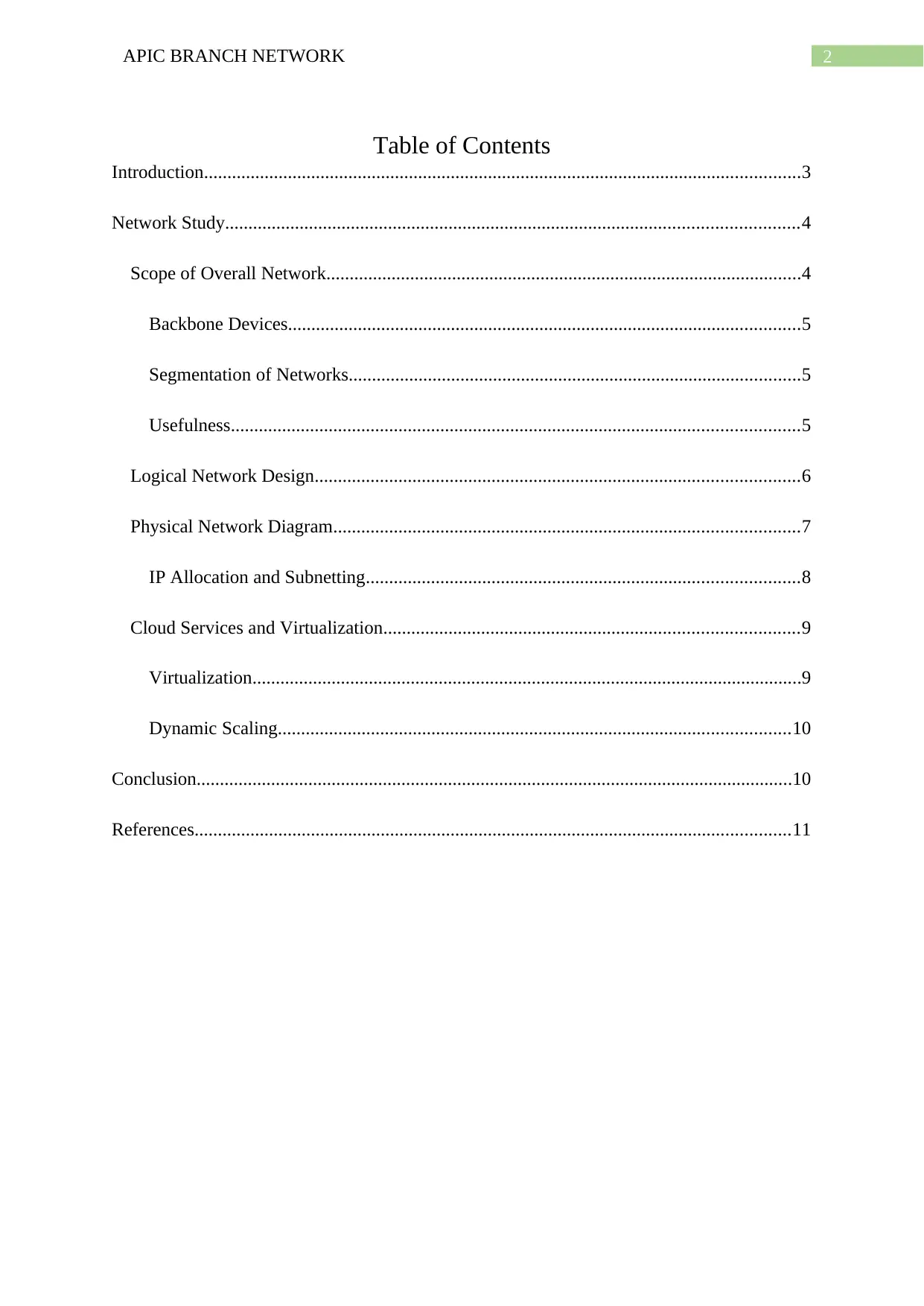
2APIC BRANCH NETWORK
Table of Contents
Introduction................................................................................................................................3
Network Study...........................................................................................................................4
Scope of Overall Network......................................................................................................4
Backbone Devices..............................................................................................................5
Segmentation of Networks.................................................................................................5
Usefulness..........................................................................................................................5
Logical Network Design........................................................................................................6
Physical Network Diagram....................................................................................................7
IP Allocation and Subnetting.............................................................................................8
Cloud Services and Virtualization.........................................................................................9
Virtualization......................................................................................................................9
Dynamic Scaling..............................................................................................................10
Conclusion................................................................................................................................10
References................................................................................................................................11
Table of Contents
Introduction................................................................................................................................3
Network Study...........................................................................................................................4
Scope of Overall Network......................................................................................................4
Backbone Devices..............................................................................................................5
Segmentation of Networks.................................................................................................5
Usefulness..........................................................................................................................5
Logical Network Design........................................................................................................6
Physical Network Diagram....................................................................................................7
IP Allocation and Subnetting.............................................................................................8
Cloud Services and Virtualization.........................................................................................9
Virtualization......................................................................................................................9
Dynamic Scaling..............................................................................................................10
Conclusion................................................................................................................................10
References................................................................................................................................11
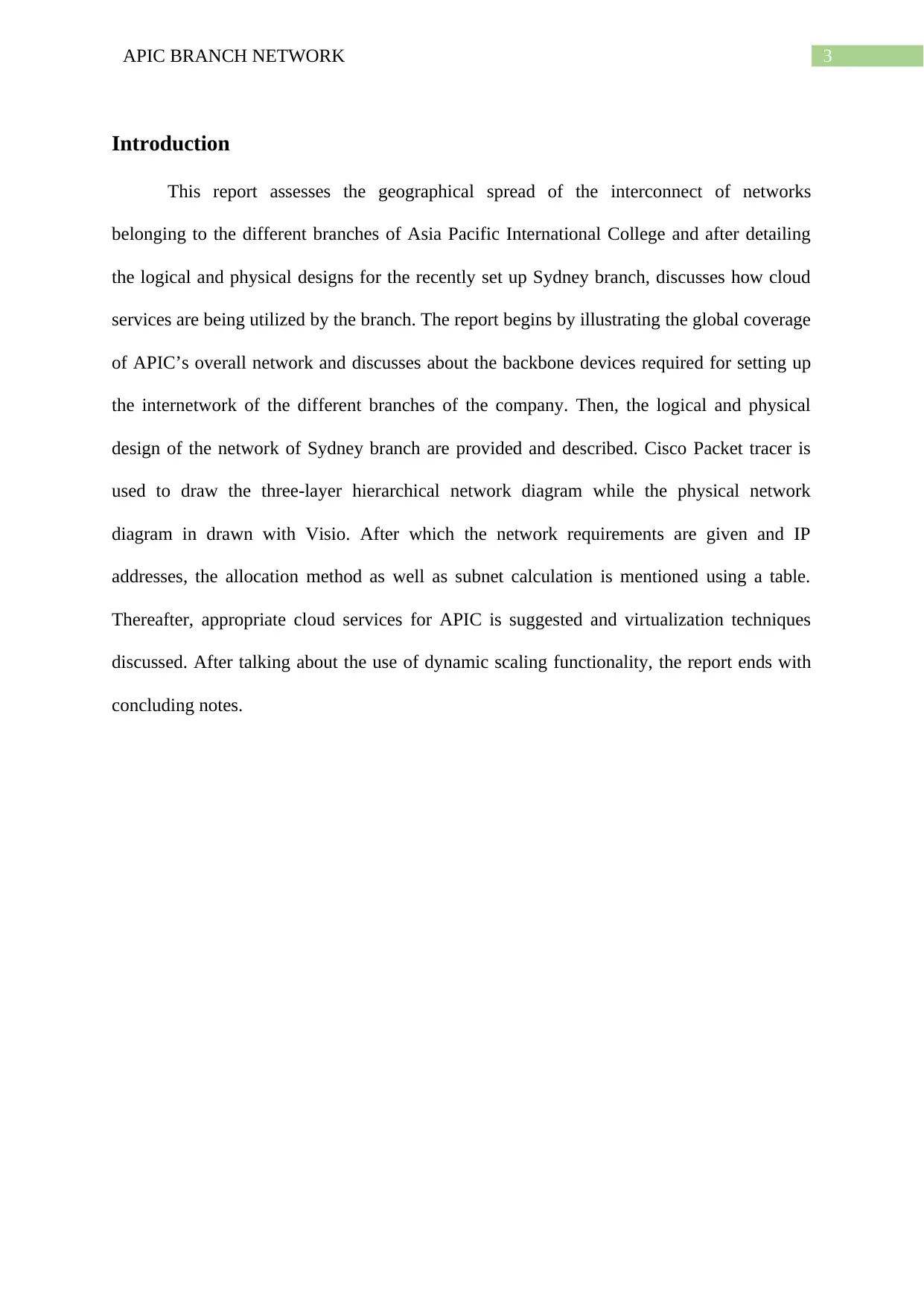
3APIC BRANCH NETWORK
Introduction
This report assesses the geographical spread of the interconnect of networks
belonging to the different branches of Asia Pacific International College and after detailing
the logical and physical designs for the recently set up Sydney branch, discusses how cloud
services are being utilized by the branch. The report begins by illustrating the global coverage
of APIC’s overall network and discusses about the backbone devices required for setting up
the internetwork of the different branches of the company. Then, the logical and physical
design of the network of Sydney branch are provided and described. Cisco Packet tracer is
used to draw the three-layer hierarchical network diagram while the physical network
diagram in drawn with Visio. After which the network requirements are given and IP
addresses, the allocation method as well as subnet calculation is mentioned using a table.
Thereafter, appropriate cloud services for APIC is suggested and virtualization techniques
discussed. After talking about the use of dynamic scaling functionality, the report ends with
concluding notes.
Introduction
This report assesses the geographical spread of the interconnect of networks
belonging to the different branches of Asia Pacific International College and after detailing
the logical and physical designs for the recently set up Sydney branch, discusses how cloud
services are being utilized by the branch. The report begins by illustrating the global coverage
of APIC’s overall network and discusses about the backbone devices required for setting up
the internetwork of the different branches of the company. Then, the logical and physical
design of the network of Sydney branch are provided and described. Cisco Packet tracer is
used to draw the three-layer hierarchical network diagram while the physical network
diagram in drawn with Visio. After which the network requirements are given and IP
addresses, the allocation method as well as subnet calculation is mentioned using a table.
Thereafter, appropriate cloud services for APIC is suggested and virtualization techniques
discussed. After talking about the use of dynamic scaling functionality, the report ends with
concluding notes.
Secure Best Marks with AI Grader
Need help grading? Try our AI Grader for instant feedback on your assignments.
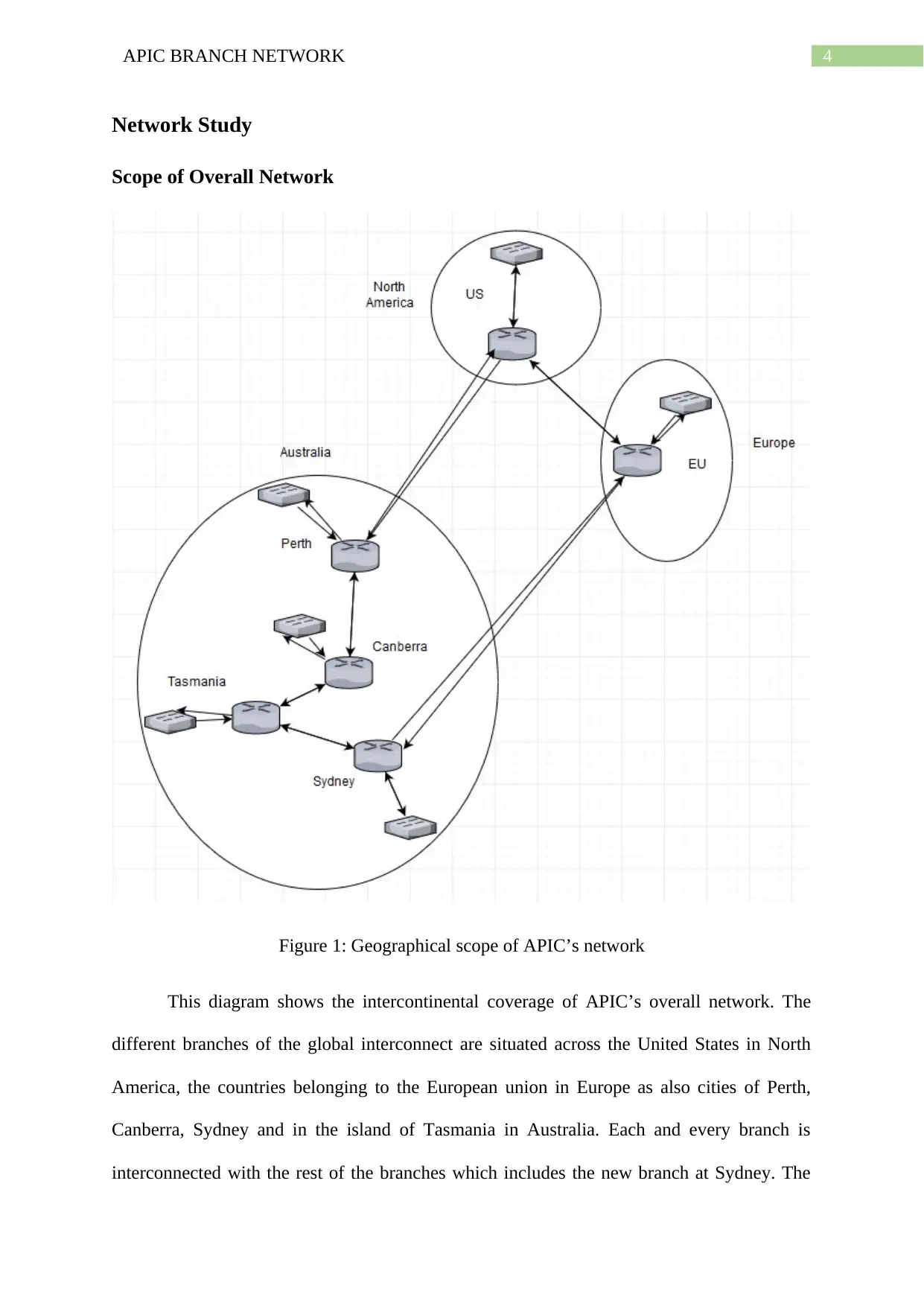
4APIC BRANCH NETWORK
Network Study
Scope of Overall Network
Figure 1: Geographical scope of APIC’s network
This diagram shows the intercontinental coverage of APIC’s overall network. The
different branches of the global interconnect are situated across the United States in North
America, the countries belonging to the European union in Europe as also cities of Perth,
Canberra, Sydney and in the island of Tasmania in Australia. Each and every branch is
interconnected with the rest of the branches which includes the new branch at Sydney. The
Network Study
Scope of Overall Network
Figure 1: Geographical scope of APIC’s network
This diagram shows the intercontinental coverage of APIC’s overall network. The
different branches of the global interconnect are situated across the United States in North
America, the countries belonging to the European union in Europe as also cities of Perth,
Canberra, Sydney and in the island of Tasmania in Australia. Each and every branch is
interconnected with the rest of the branches which includes the new branch at Sydney. The
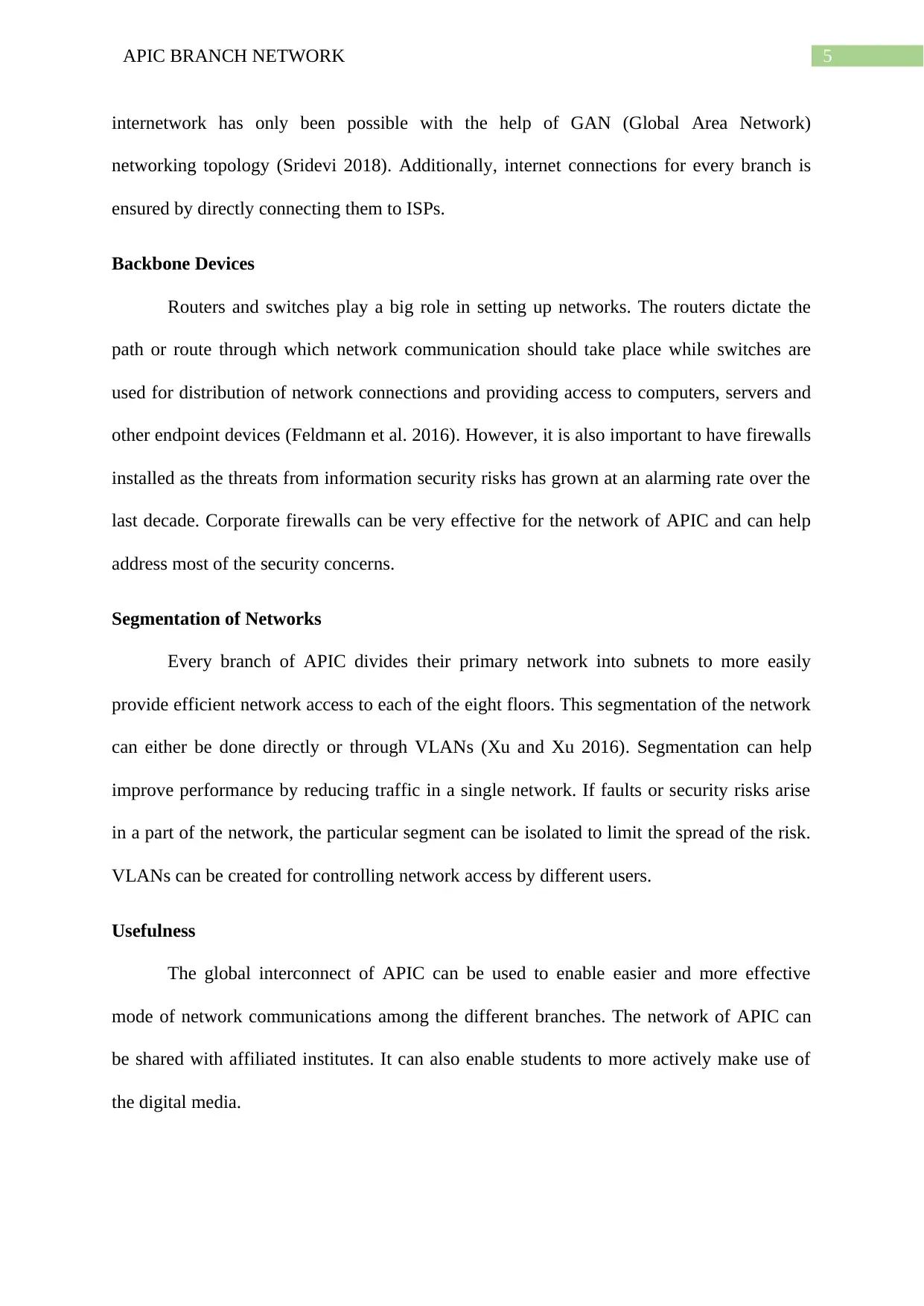
5APIC BRANCH NETWORK
internetwork has only been possible with the help of GAN (Global Area Network)
networking topology (Sridevi 2018). Additionally, internet connections for every branch is
ensured by directly connecting them to ISPs.
Backbone Devices
Routers and switches play a big role in setting up networks. The routers dictate the
path or route through which network communication should take place while switches are
used for distribution of network connections and providing access to computers, servers and
other endpoint devices (Feldmann et al. 2016). However, it is also important to have firewalls
installed as the threats from information security risks has grown at an alarming rate over the
last decade. Corporate firewalls can be very effective for the network of APIC and can help
address most of the security concerns.
Segmentation of Networks
Every branch of APIC divides their primary network into subnets to more easily
provide efficient network access to each of the eight floors. This segmentation of the network
can either be done directly or through VLANs (Xu and Xu 2016). Segmentation can help
improve performance by reducing traffic in a single network. If faults or security risks arise
in a part of the network, the particular segment can be isolated to limit the spread of the risk.
VLANs can be created for controlling network access by different users.
Usefulness
The global interconnect of APIC can be used to enable easier and more effective
mode of network communications among the different branches. The network of APIC can
be shared with affiliated institutes. It can also enable students to more actively make use of
the digital media.
internetwork has only been possible with the help of GAN (Global Area Network)
networking topology (Sridevi 2018). Additionally, internet connections for every branch is
ensured by directly connecting them to ISPs.
Backbone Devices
Routers and switches play a big role in setting up networks. The routers dictate the
path or route through which network communication should take place while switches are
used for distribution of network connections and providing access to computers, servers and
other endpoint devices (Feldmann et al. 2016). However, it is also important to have firewalls
installed as the threats from information security risks has grown at an alarming rate over the
last decade. Corporate firewalls can be very effective for the network of APIC and can help
address most of the security concerns.
Segmentation of Networks
Every branch of APIC divides their primary network into subnets to more easily
provide efficient network access to each of the eight floors. This segmentation of the network
can either be done directly or through VLANs (Xu and Xu 2016). Segmentation can help
improve performance by reducing traffic in a single network. If faults or security risks arise
in a part of the network, the particular segment can be isolated to limit the spread of the risk.
VLANs can be created for controlling network access by different users.
Usefulness
The global interconnect of APIC can be used to enable easier and more effective
mode of network communications among the different branches. The network of APIC can
be shared with affiliated institutes. It can also enable students to more actively make use of
the digital media.
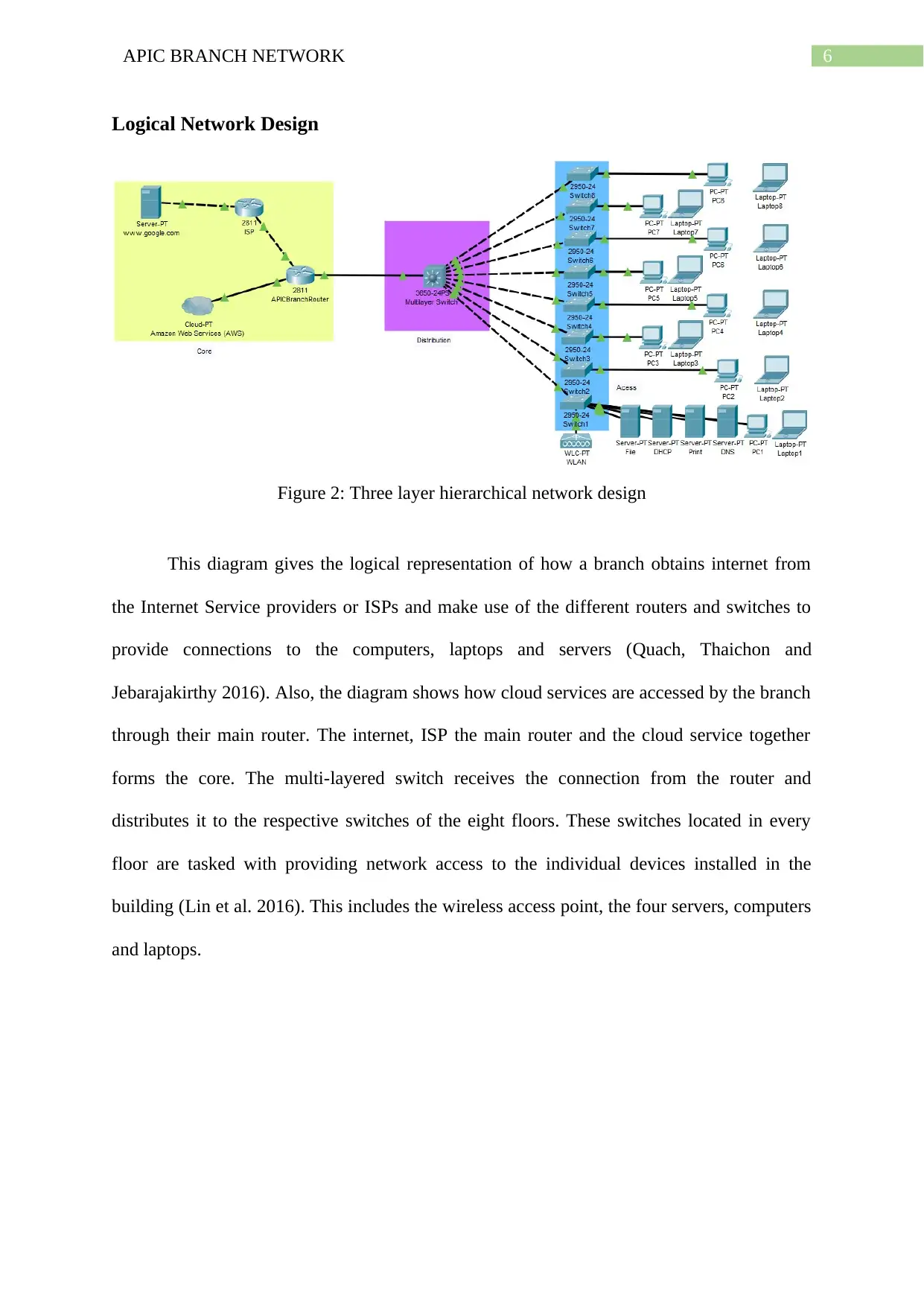
6APIC BRANCH NETWORK
Logical Network Design
Figure 2: Three layer hierarchical network design
This diagram gives the logical representation of how a branch obtains internet from
the Internet Service providers or ISPs and make use of the different routers and switches to
provide connections to the computers, laptops and servers (Quach, Thaichon and
Jebarajakirthy 2016). Also, the diagram shows how cloud services are accessed by the branch
through their main router. The internet, ISP the main router and the cloud service together
forms the core. The multi-layered switch receives the connection from the router and
distributes it to the respective switches of the eight floors. These switches located in every
floor are tasked with providing network access to the individual devices installed in the
building (Lin et al. 2016). This includes the wireless access point, the four servers, computers
and laptops.
Logical Network Design
Figure 2: Three layer hierarchical network design
This diagram gives the logical representation of how a branch obtains internet from
the Internet Service providers or ISPs and make use of the different routers and switches to
provide connections to the computers, laptops and servers (Quach, Thaichon and
Jebarajakirthy 2016). Also, the diagram shows how cloud services are accessed by the branch
through their main router. The internet, ISP the main router and the cloud service together
forms the core. The multi-layered switch receives the connection from the router and
distributes it to the respective switches of the eight floors. These switches located in every
floor are tasked with providing network access to the individual devices installed in the
building (Lin et al. 2016). This includes the wireless access point, the four servers, computers
and laptops.
Paraphrase This Document
Need a fresh take? Get an instant paraphrase of this document with our AI Paraphraser
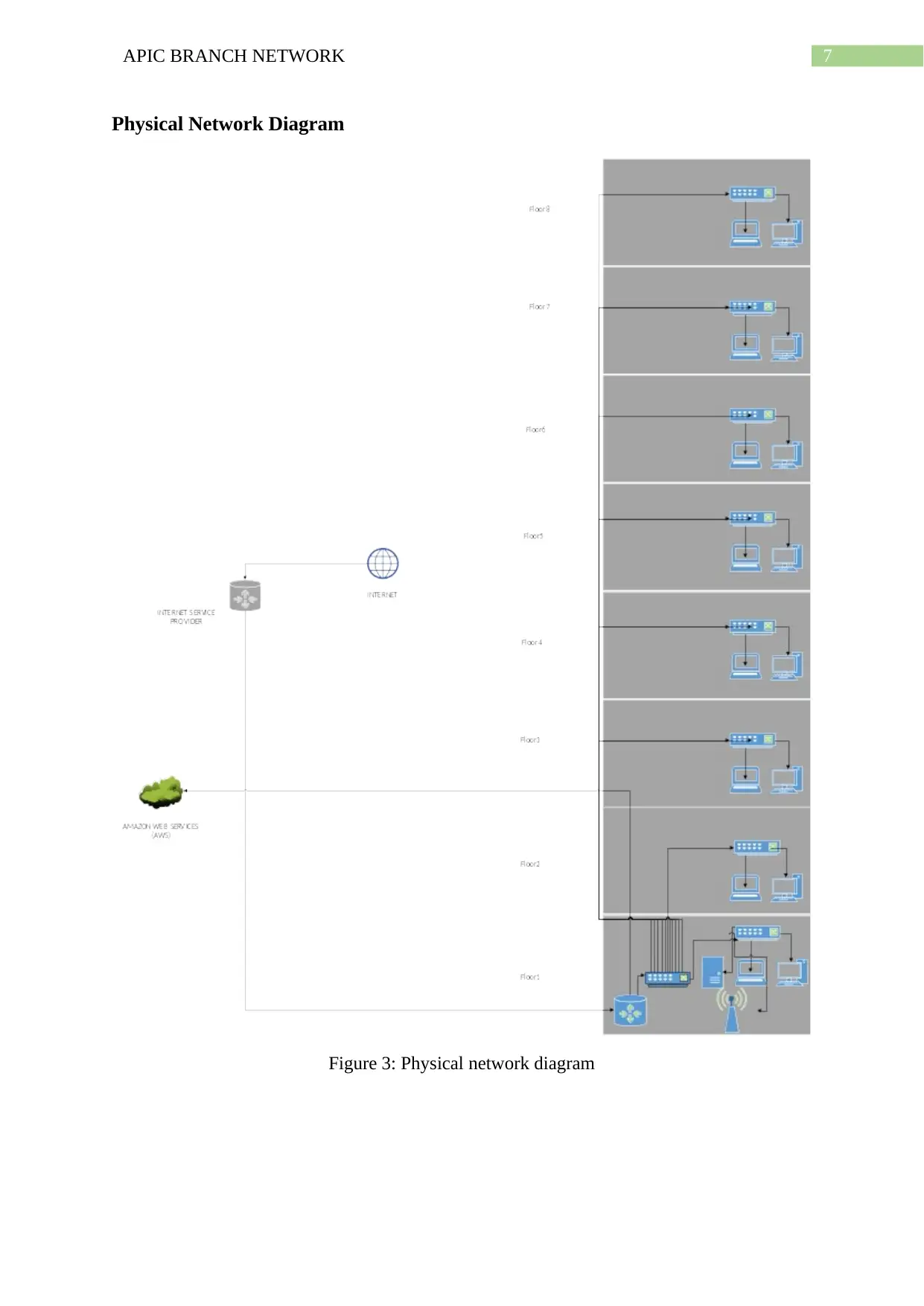
7APIC BRANCH NETWORK
Physical Network Diagram
Figure 3: Physical network diagram
Physical Network Diagram
Figure 3: Physical network diagram
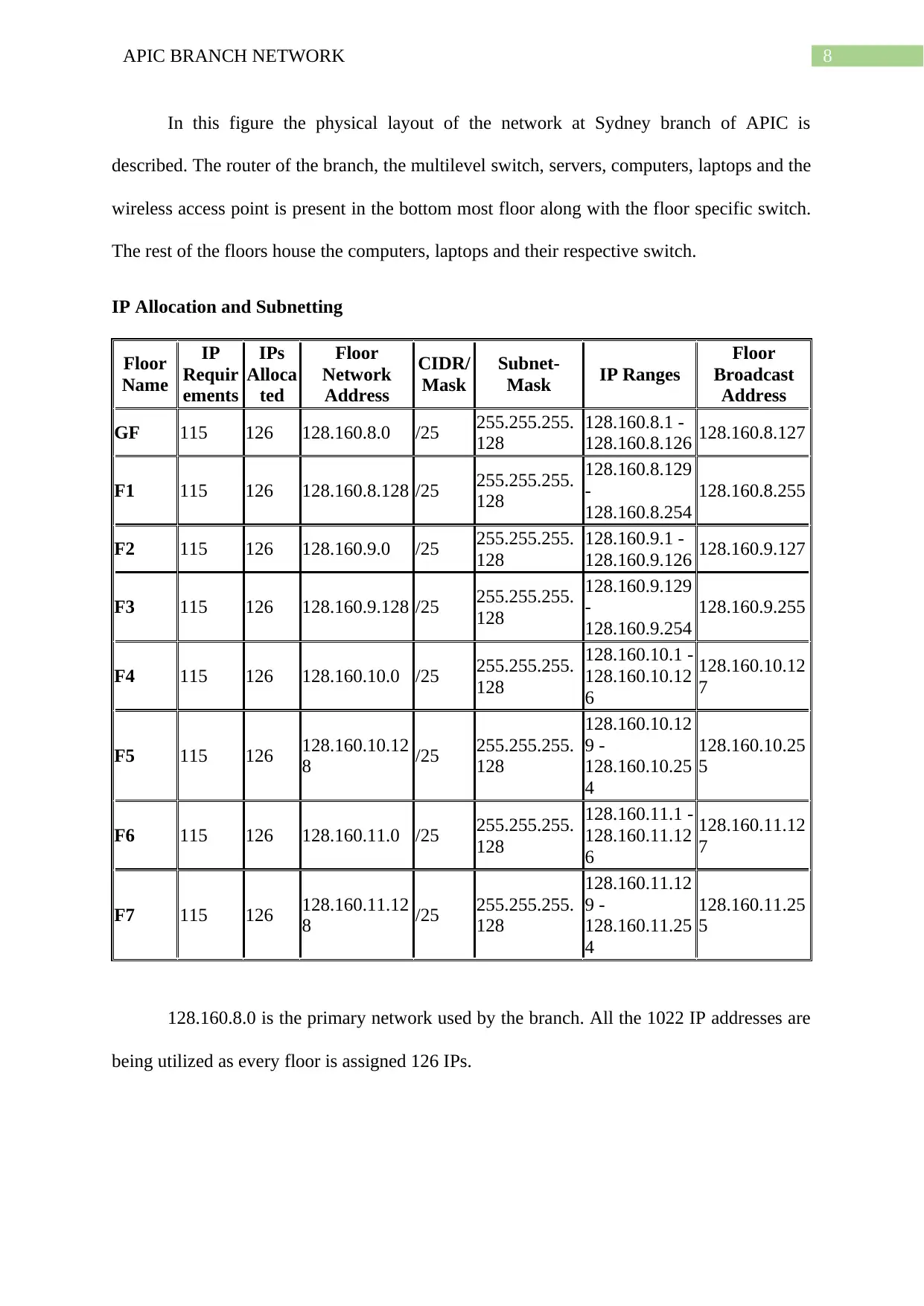
8APIC BRANCH NETWORK
In this figure the physical layout of the network at Sydney branch of APIC is
described. The router of the branch, the multilevel switch, servers, computers, laptops and the
wireless access point is present in the bottom most floor along with the floor specific switch.
The rest of the floors house the computers, laptops and their respective switch.
IP Allocation and Subnetting
Floor
Name
IP
Requir
ements
IPs
Alloca
ted
Floor
Network
Address
CIDR/
Mask
Subnet-
Mask IP Ranges
Floor
Broadcast
Address
GF 115 126 128.160.8.0 /25 255.255.255.
128
128.160.8.1 -
128.160.8.126 128.160.8.127
F1 115 126 128.160.8.128 /25 255.255.255.
128
128.160.8.129
-
128.160.8.254
128.160.8.255
F2 115 126 128.160.9.0 /25 255.255.255.
128
128.160.9.1 -
128.160.9.126 128.160.9.127
F3 115 126 128.160.9.128 /25 255.255.255.
128
128.160.9.129
-
128.160.9.254
128.160.9.255
F4 115 126 128.160.10.0 /25 255.255.255.
128
128.160.10.1 -
128.160.10.12
6
128.160.10.12
7
F5 115 126 128.160.10.12
8 /25 255.255.255.
128
128.160.10.12
9 -
128.160.10.25
4
128.160.10.25
5
F6 115 126 128.160.11.0 /25 255.255.255.
128
128.160.11.1 -
128.160.11.12
6
128.160.11.12
7
F7 115 126 128.160.11.12
8 /25 255.255.255.
128
128.160.11.12
9 -
128.160.11.25
4
128.160.11.25
5
128.160.8.0 is the primary network used by the branch. All the 1022 IP addresses are
being utilized as every floor is assigned 126 IPs.
In this figure the physical layout of the network at Sydney branch of APIC is
described. The router of the branch, the multilevel switch, servers, computers, laptops and the
wireless access point is present in the bottom most floor along with the floor specific switch.
The rest of the floors house the computers, laptops and their respective switch.
IP Allocation and Subnetting
Floor
Name
IP
Requir
ements
IPs
Alloca
ted
Floor
Network
Address
CIDR/
Mask
Subnet-
Mask IP Ranges
Floor
Broadcast
Address
GF 115 126 128.160.8.0 /25 255.255.255.
128
128.160.8.1 -
128.160.8.126 128.160.8.127
F1 115 126 128.160.8.128 /25 255.255.255.
128
128.160.8.129
-
128.160.8.254
128.160.8.255
F2 115 126 128.160.9.0 /25 255.255.255.
128
128.160.9.1 -
128.160.9.126 128.160.9.127
F3 115 126 128.160.9.128 /25 255.255.255.
128
128.160.9.129
-
128.160.9.254
128.160.9.255
F4 115 126 128.160.10.0 /25 255.255.255.
128
128.160.10.1 -
128.160.10.12
6
128.160.10.12
7
F5 115 126 128.160.10.12
8 /25 255.255.255.
128
128.160.10.12
9 -
128.160.10.25
4
128.160.10.25
5
F6 115 126 128.160.11.0 /25 255.255.255.
128
128.160.11.1 -
128.160.11.12
6
128.160.11.12
7
F7 115 126 128.160.11.12
8 /25 255.255.255.
128
128.160.11.12
9 -
128.160.11.25
4
128.160.11.25
5
128.160.8.0 is the primary network used by the branch. All the 1022 IP addresses are
being utilized as every floor is assigned 126 IPs.
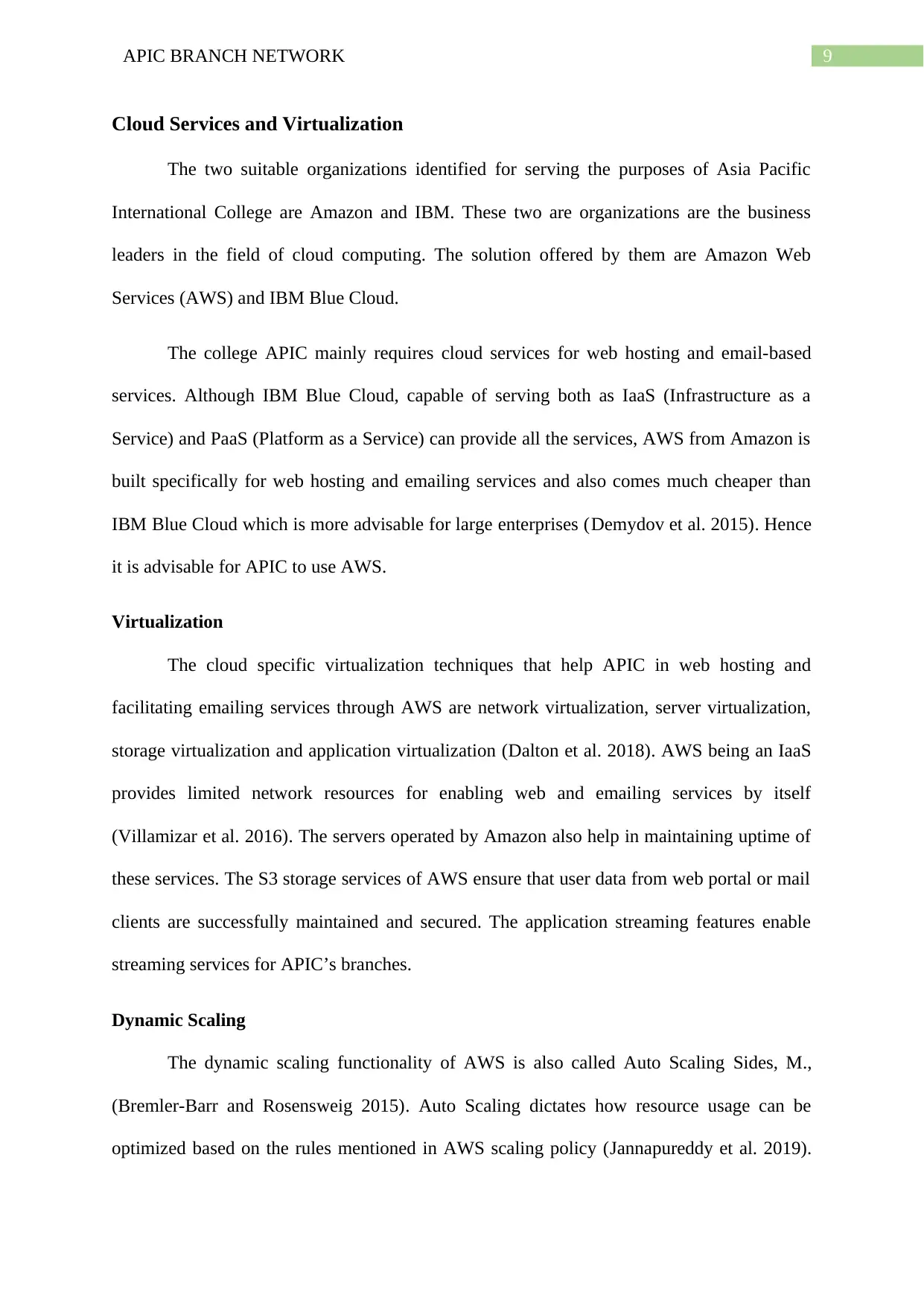
9APIC BRANCH NETWORK
Cloud Services and Virtualization
The two suitable organizations identified for serving the purposes of Asia Pacific
International College are Amazon and IBM. These two are organizations are the business
leaders in the field of cloud computing. The solution offered by them are Amazon Web
Services (AWS) and IBM Blue Cloud.
The college APIC mainly requires cloud services for web hosting and email-based
services. Although IBM Blue Cloud, capable of serving both as IaaS (Infrastructure as a
Service) and PaaS (Platform as a Service) can provide all the services, AWS from Amazon is
built specifically for web hosting and emailing services and also comes much cheaper than
IBM Blue Cloud which is more advisable for large enterprises (Demydov et al. 2015). Hence
it is advisable for APIC to use AWS.
Virtualization
The cloud specific virtualization techniques that help APIC in web hosting and
facilitating emailing services through AWS are network virtualization, server virtualization,
storage virtualization and application virtualization (Dalton et al. 2018). AWS being an IaaS
provides limited network resources for enabling web and emailing services by itself
(Villamizar et al. 2016). The servers operated by Amazon also help in maintaining uptime of
these services. The S3 storage services of AWS ensure that user data from web portal or mail
clients are successfully maintained and secured. The application streaming features enable
streaming services for APIC’s branches.
Dynamic Scaling
The dynamic scaling functionality of AWS is also called Auto Scaling Sides, M.,
(Bremler-Barr and Rosensweig 2015). Auto Scaling dictates how resource usage can be
optimized based on the rules mentioned in AWS scaling policy (Jannapureddy et al. 2019).
Cloud Services and Virtualization
The two suitable organizations identified for serving the purposes of Asia Pacific
International College are Amazon and IBM. These two are organizations are the business
leaders in the field of cloud computing. The solution offered by them are Amazon Web
Services (AWS) and IBM Blue Cloud.
The college APIC mainly requires cloud services for web hosting and email-based
services. Although IBM Blue Cloud, capable of serving both as IaaS (Infrastructure as a
Service) and PaaS (Platform as a Service) can provide all the services, AWS from Amazon is
built specifically for web hosting and emailing services and also comes much cheaper than
IBM Blue Cloud which is more advisable for large enterprises (Demydov et al. 2015). Hence
it is advisable for APIC to use AWS.
Virtualization
The cloud specific virtualization techniques that help APIC in web hosting and
facilitating emailing services through AWS are network virtualization, server virtualization,
storage virtualization and application virtualization (Dalton et al. 2018). AWS being an IaaS
provides limited network resources for enabling web and emailing services by itself
(Villamizar et al. 2016). The servers operated by Amazon also help in maintaining uptime of
these services. The S3 storage services of AWS ensure that user data from web portal or mail
clients are successfully maintained and secured. The application streaming features enable
streaming services for APIC’s branches.
Dynamic Scaling
The dynamic scaling functionality of AWS is also called Auto Scaling Sides, M.,
(Bremler-Barr and Rosensweig 2015). Auto Scaling dictates how resource usage can be
optimized based on the rules mentioned in AWS scaling policy (Jannapureddy et al. 2019).
Secure Best Marks with AI Grader
Need help grading? Try our AI Grader for instant feedback on your assignments.
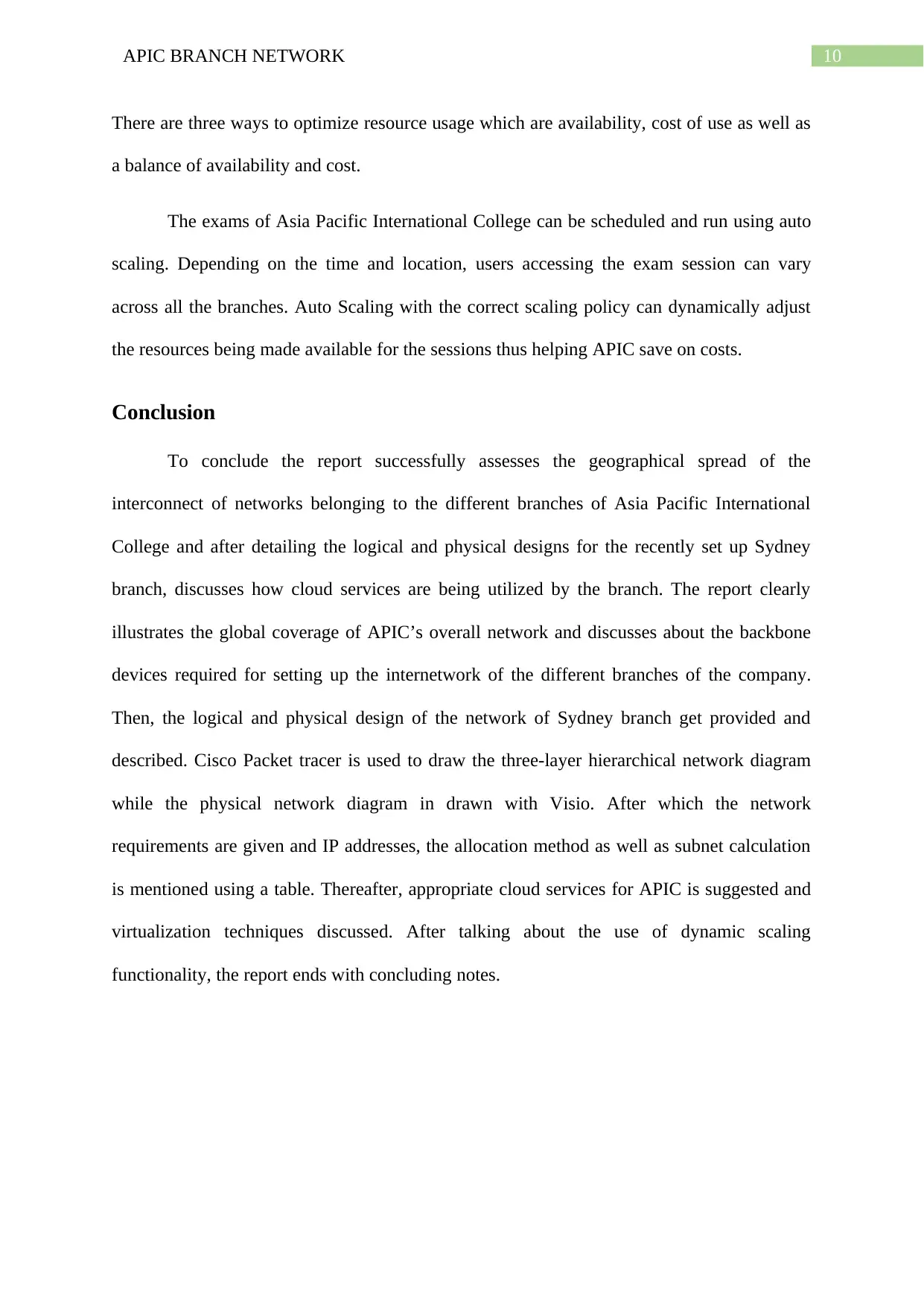
10APIC BRANCH NETWORK
There are three ways to optimize resource usage which are availability, cost of use as well as
a balance of availability and cost.
The exams of Asia Pacific International College can be scheduled and run using auto
scaling. Depending on the time and location, users accessing the exam session can vary
across all the branches. Auto Scaling with the correct scaling policy can dynamically adjust
the resources being made available for the sessions thus helping APIC save on costs.
Conclusion
To conclude the report successfully assesses the geographical spread of the
interconnect of networks belonging to the different branches of Asia Pacific International
College and after detailing the logical and physical designs for the recently set up Sydney
branch, discusses how cloud services are being utilized by the branch. The report clearly
illustrates the global coverage of APIC’s overall network and discusses about the backbone
devices required for setting up the internetwork of the different branches of the company.
Then, the logical and physical design of the network of Sydney branch get provided and
described. Cisco Packet tracer is used to draw the three-layer hierarchical network diagram
while the physical network diagram in drawn with Visio. After which the network
requirements are given and IP addresses, the allocation method as well as subnet calculation
is mentioned using a table. Thereafter, appropriate cloud services for APIC is suggested and
virtualization techniques discussed. After talking about the use of dynamic scaling
functionality, the report ends with concluding notes.
There are three ways to optimize resource usage which are availability, cost of use as well as
a balance of availability and cost.
The exams of Asia Pacific International College can be scheduled and run using auto
scaling. Depending on the time and location, users accessing the exam session can vary
across all the branches. Auto Scaling with the correct scaling policy can dynamically adjust
the resources being made available for the sessions thus helping APIC save on costs.
Conclusion
To conclude the report successfully assesses the geographical spread of the
interconnect of networks belonging to the different branches of Asia Pacific International
College and after detailing the logical and physical designs for the recently set up Sydney
branch, discusses how cloud services are being utilized by the branch. The report clearly
illustrates the global coverage of APIC’s overall network and discusses about the backbone
devices required for setting up the internetwork of the different branches of the company.
Then, the logical and physical design of the network of Sydney branch get provided and
described. Cisco Packet tracer is used to draw the three-layer hierarchical network diagram
while the physical network diagram in drawn with Visio. After which the network
requirements are given and IP addresses, the allocation method as well as subnet calculation
is mentioned using a table. Thereafter, appropriate cloud services for APIC is suggested and
virtualization techniques discussed. After talking about the use of dynamic scaling
functionality, the report ends with concluding notes.
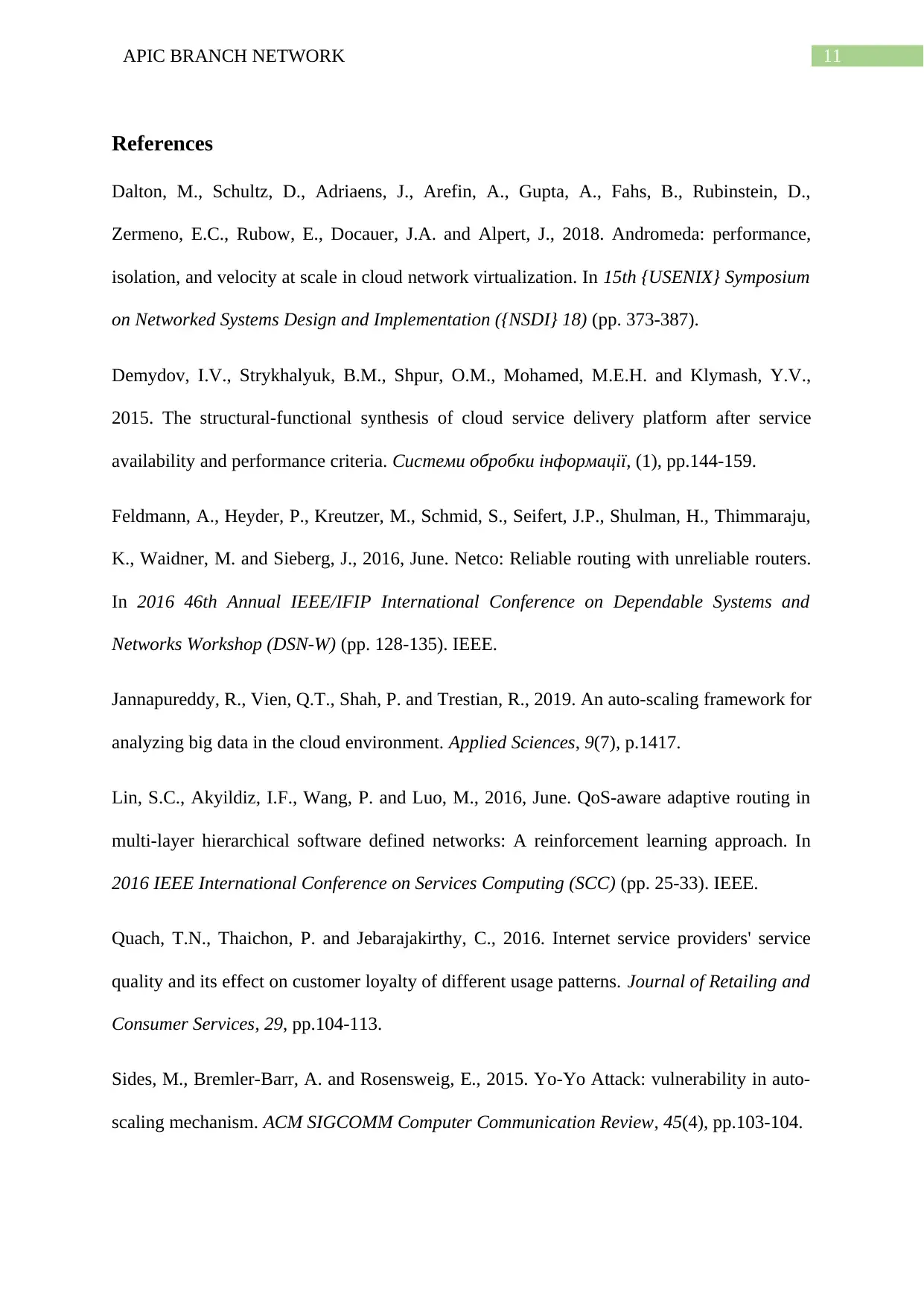
11APIC BRANCH NETWORK
References
Dalton, M., Schultz, D., Adriaens, J., Arefin, A., Gupta, A., Fahs, B., Rubinstein, D.,
Zermeno, E.C., Rubow, E., Docauer, J.A. and Alpert, J., 2018. Andromeda: performance,
isolation, and velocity at scale in cloud network virtualization. In 15th {USENIX} Symposium
on Networked Systems Design and Implementation ({NSDI} 18) (pp. 373-387).
Demydov, I.V., Strykhalyuk, B.M., Shpur, O.M., Mohamed, M.E.H. and Klymash, Y.V.,
2015. The structural-functional synthesis of cloud service delivery platform after service
availability and performance criteria. Системи обробки інформації, (1), pp.144-159.
Feldmann, A., Heyder, P., Kreutzer, M., Schmid, S., Seifert, J.P., Shulman, H., Thimmaraju,
K., Waidner, M. and Sieberg, J., 2016, June. Netco: Reliable routing with unreliable routers.
In 2016 46th Annual IEEE/IFIP International Conference on Dependable Systems and
Networks Workshop (DSN-W) (pp. 128-135). IEEE.
Jannapureddy, R., Vien, Q.T., Shah, P. and Trestian, R., 2019. An auto-scaling framework for
analyzing big data in the cloud environment. Applied Sciences, 9(7), p.1417.
Lin, S.C., Akyildiz, I.F., Wang, P. and Luo, M., 2016, June. QoS-aware adaptive routing in
multi-layer hierarchical software defined networks: A reinforcement learning approach. In
2016 IEEE International Conference on Services Computing (SCC) (pp. 25-33). IEEE.
Quach, T.N., Thaichon, P. and Jebarajakirthy, C., 2016. Internet service providers' service
quality and its effect on customer loyalty of different usage patterns. Journal of Retailing and
Consumer Services, 29, pp.104-113.
Sides, M., Bremler-Barr, A. and Rosensweig, E., 2015. Yo-Yo Attack: vulnerability in auto-
scaling mechanism. ACM SIGCOMM Computer Communication Review, 45(4), pp.103-104.
References
Dalton, M., Schultz, D., Adriaens, J., Arefin, A., Gupta, A., Fahs, B., Rubinstein, D.,
Zermeno, E.C., Rubow, E., Docauer, J.A. and Alpert, J., 2018. Andromeda: performance,
isolation, and velocity at scale in cloud network virtualization. In 15th {USENIX} Symposium
on Networked Systems Design and Implementation ({NSDI} 18) (pp. 373-387).
Demydov, I.V., Strykhalyuk, B.M., Shpur, O.M., Mohamed, M.E.H. and Klymash, Y.V.,
2015. The structural-functional synthesis of cloud service delivery platform after service
availability and performance criteria. Системи обробки інформації, (1), pp.144-159.
Feldmann, A., Heyder, P., Kreutzer, M., Schmid, S., Seifert, J.P., Shulman, H., Thimmaraju,
K., Waidner, M. and Sieberg, J., 2016, June. Netco: Reliable routing with unreliable routers.
In 2016 46th Annual IEEE/IFIP International Conference on Dependable Systems and
Networks Workshop (DSN-W) (pp. 128-135). IEEE.
Jannapureddy, R., Vien, Q.T., Shah, P. and Trestian, R., 2019. An auto-scaling framework for
analyzing big data in the cloud environment. Applied Sciences, 9(7), p.1417.
Lin, S.C., Akyildiz, I.F., Wang, P. and Luo, M., 2016, June. QoS-aware adaptive routing in
multi-layer hierarchical software defined networks: A reinforcement learning approach. In
2016 IEEE International Conference on Services Computing (SCC) (pp. 25-33). IEEE.
Quach, T.N., Thaichon, P. and Jebarajakirthy, C., 2016. Internet service providers' service
quality and its effect on customer loyalty of different usage patterns. Journal of Retailing and
Consumer Services, 29, pp.104-113.
Sides, M., Bremler-Barr, A. and Rosensweig, E., 2015. Yo-Yo Attack: vulnerability in auto-
scaling mechanism. ACM SIGCOMM Computer Communication Review, 45(4), pp.103-104.
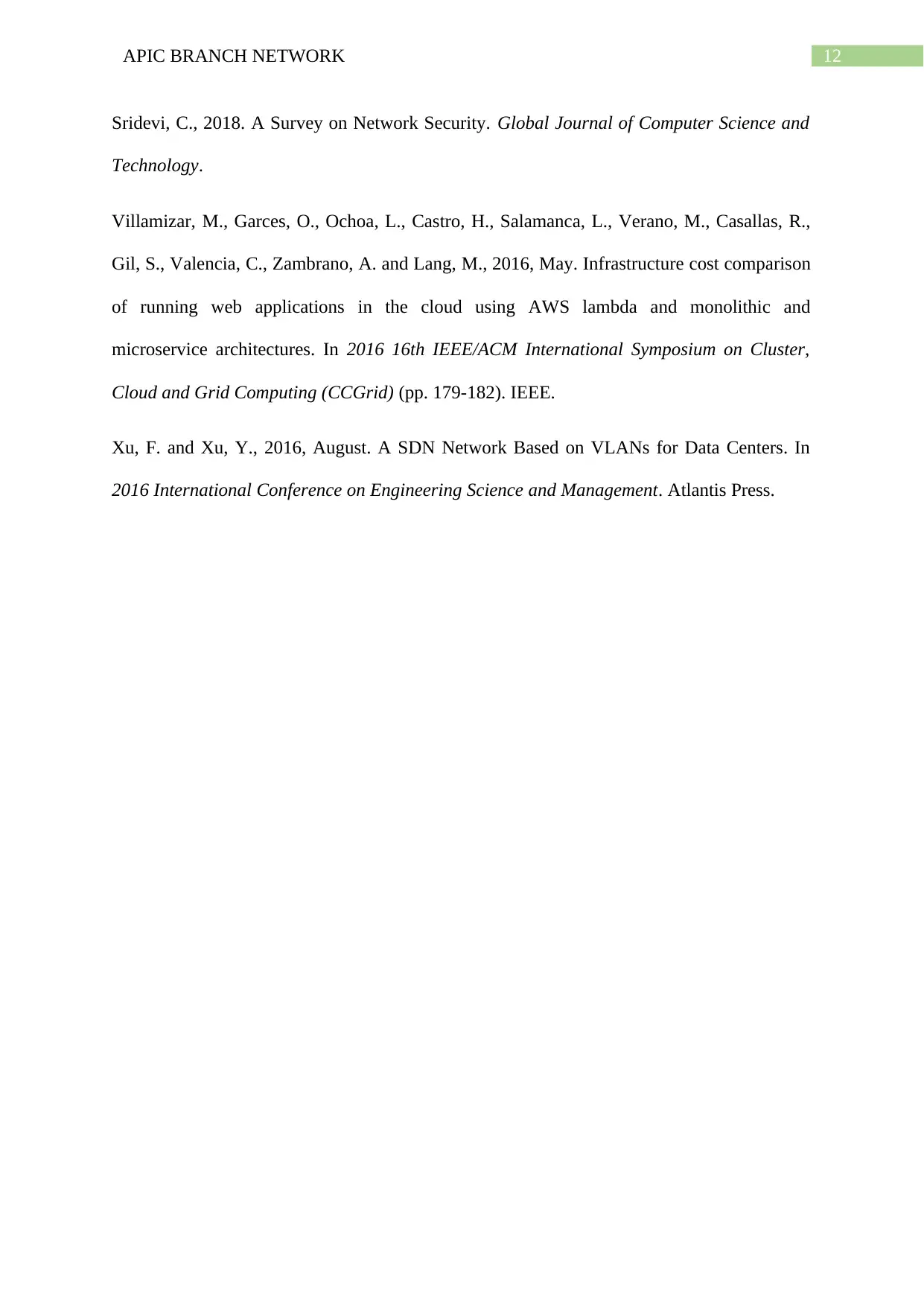
12APIC BRANCH NETWORK
Sridevi, C., 2018. A Survey on Network Security. Global Journal of Computer Science and
Technology.
Villamizar, M., Garces, O., Ochoa, L., Castro, H., Salamanca, L., Verano, M., Casallas, R.,
Gil, S., Valencia, C., Zambrano, A. and Lang, M., 2016, May. Infrastructure cost comparison
of running web applications in the cloud using AWS lambda and monolithic and
microservice architectures. In 2016 16th IEEE/ACM International Symposium on Cluster,
Cloud and Grid Computing (CCGrid) (pp. 179-182). IEEE.
Xu, F. and Xu, Y., 2016, August. A SDN Network Based on VLANs for Data Centers. In
2016 International Conference on Engineering Science and Management. Atlantis Press.
Sridevi, C., 2018. A Survey on Network Security. Global Journal of Computer Science and
Technology.
Villamizar, M., Garces, O., Ochoa, L., Castro, H., Salamanca, L., Verano, M., Casallas, R.,
Gil, S., Valencia, C., Zambrano, A. and Lang, M., 2016, May. Infrastructure cost comparison
of running web applications in the cloud using AWS lambda and monolithic and
microservice architectures. In 2016 16th IEEE/ACM International Symposium on Cluster,
Cloud and Grid Computing (CCGrid) (pp. 179-182). IEEE.
Xu, F. and Xu, Y., 2016, August. A SDN Network Based on VLANs for Data Centers. In
2016 International Conference on Engineering Science and Management. Atlantis Press.
Paraphrase This Document
Need a fresh take? Get an instant paraphrase of this document with our AI Paraphraser
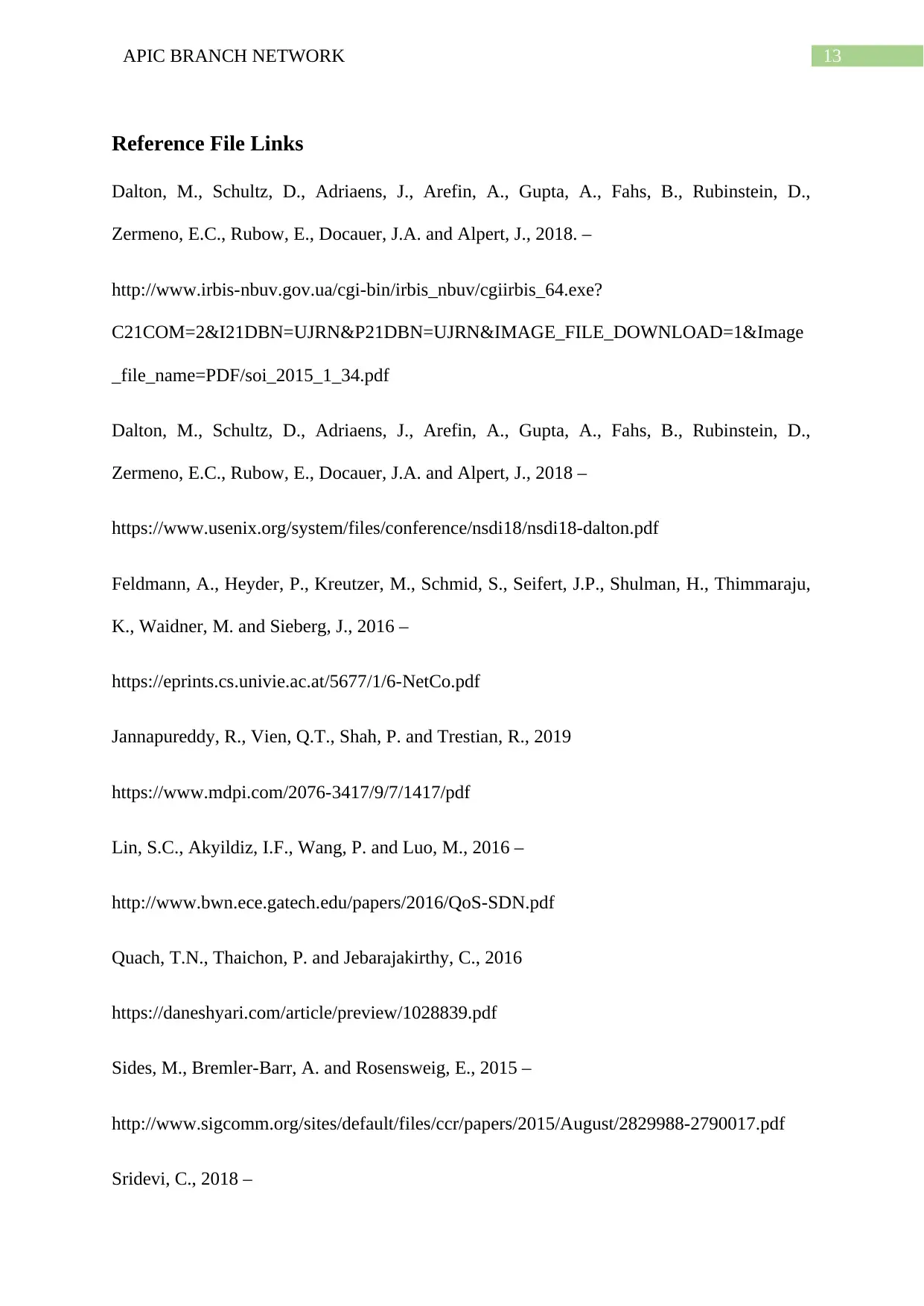
13APIC BRANCH NETWORK
Reference File Links
Dalton, M., Schultz, D., Adriaens, J., Arefin, A., Gupta, A., Fahs, B., Rubinstein, D.,
Zermeno, E.C., Rubow, E., Docauer, J.A. and Alpert, J., 2018. –
http://www.irbis-nbuv.gov.ua/cgi-bin/irbis_nbuv/cgiirbis_64.exe?
C21COM=2&I21DBN=UJRN&P21DBN=UJRN&IMAGE_FILE_DOWNLOAD=1&Image
_file_name=PDF/soi_2015_1_34.pdf
Dalton, M., Schultz, D., Adriaens, J., Arefin, A., Gupta, A., Fahs, B., Rubinstein, D.,
Zermeno, E.C., Rubow, E., Docauer, J.A. and Alpert, J., 2018 –
https://www.usenix.org/system/files/conference/nsdi18/nsdi18-dalton.pdf
Feldmann, A., Heyder, P., Kreutzer, M., Schmid, S., Seifert, J.P., Shulman, H., Thimmaraju,
K., Waidner, M. and Sieberg, J., 2016 –
https://eprints.cs.univie.ac.at/5677/1/6-NetCo.pdf
Jannapureddy, R., Vien, Q.T., Shah, P. and Trestian, R., 2019
https://www.mdpi.com/2076-3417/9/7/1417/pdf
Lin, S.C., Akyildiz, I.F., Wang, P. and Luo, M., 2016 –
http://www.bwn.ece.gatech.edu/papers/2016/QoS-SDN.pdf
Quach, T.N., Thaichon, P. and Jebarajakirthy, C., 2016
https://daneshyari.com/article/preview/1028839.pdf
Sides, M., Bremler-Barr, A. and Rosensweig, E., 2015 –
http://www.sigcomm.org/sites/default/files/ccr/papers/2015/August/2829988-2790017.pdf
Sridevi, C., 2018 –
Reference File Links
Dalton, M., Schultz, D., Adriaens, J., Arefin, A., Gupta, A., Fahs, B., Rubinstein, D.,
Zermeno, E.C., Rubow, E., Docauer, J.A. and Alpert, J., 2018. –
http://www.irbis-nbuv.gov.ua/cgi-bin/irbis_nbuv/cgiirbis_64.exe?
C21COM=2&I21DBN=UJRN&P21DBN=UJRN&IMAGE_FILE_DOWNLOAD=1&Image
_file_name=PDF/soi_2015_1_34.pdf
Dalton, M., Schultz, D., Adriaens, J., Arefin, A., Gupta, A., Fahs, B., Rubinstein, D.,
Zermeno, E.C., Rubow, E., Docauer, J.A. and Alpert, J., 2018 –
https://www.usenix.org/system/files/conference/nsdi18/nsdi18-dalton.pdf
Feldmann, A., Heyder, P., Kreutzer, M., Schmid, S., Seifert, J.P., Shulman, H., Thimmaraju,
K., Waidner, M. and Sieberg, J., 2016 –
https://eprints.cs.univie.ac.at/5677/1/6-NetCo.pdf
Jannapureddy, R., Vien, Q.T., Shah, P. and Trestian, R., 2019
https://www.mdpi.com/2076-3417/9/7/1417/pdf
Lin, S.C., Akyildiz, I.F., Wang, P. and Luo, M., 2016 –
http://www.bwn.ece.gatech.edu/papers/2016/QoS-SDN.pdf
Quach, T.N., Thaichon, P. and Jebarajakirthy, C., 2016
https://daneshyari.com/article/preview/1028839.pdf
Sides, M., Bremler-Barr, A. and Rosensweig, E., 2015 –
http://www.sigcomm.org/sites/default/files/ccr/papers/2015/August/2829988-2790017.pdf
Sridevi, C., 2018 –
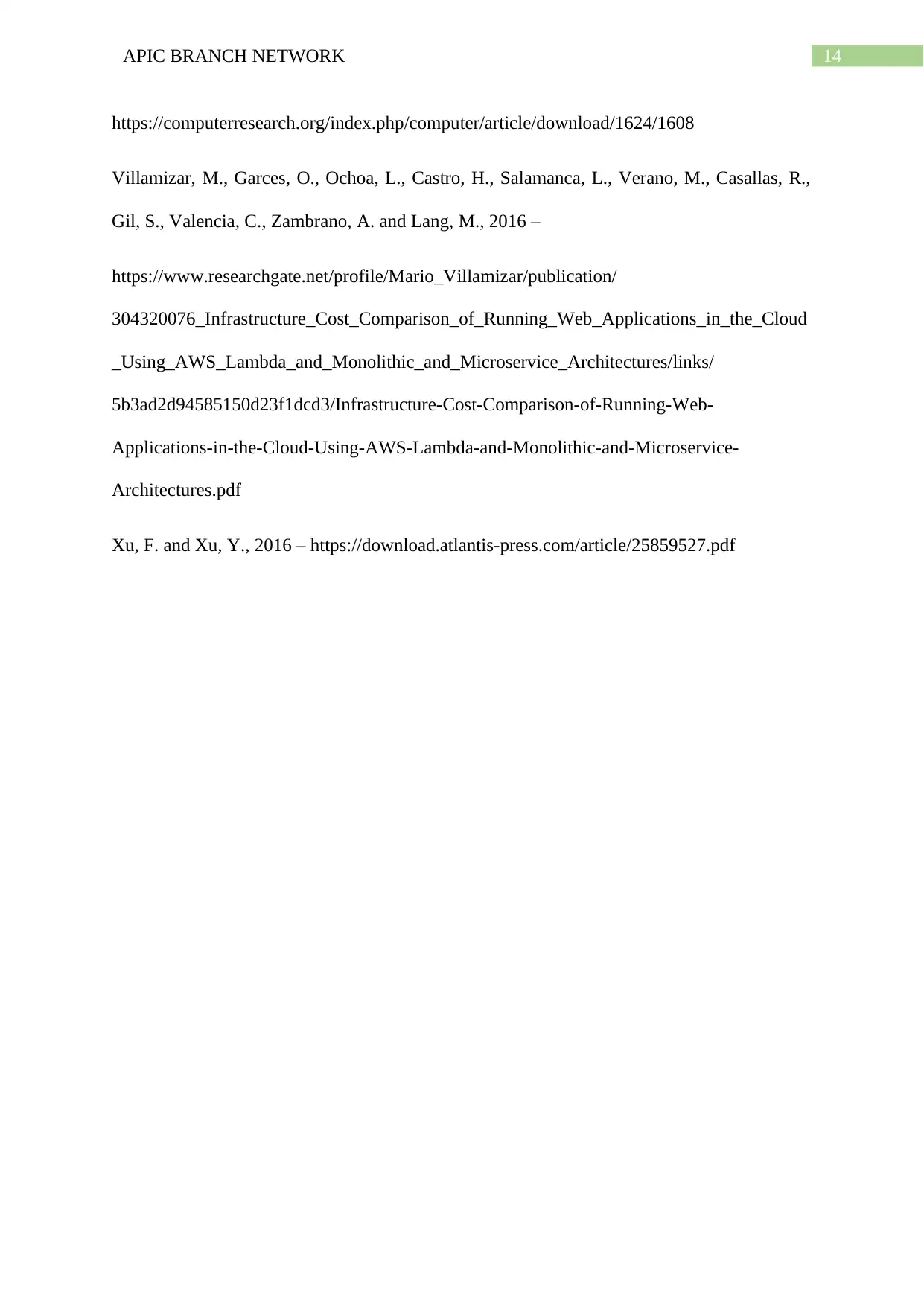
14APIC BRANCH NETWORK
https://computerresearch.org/index.php/computer/article/download/1624/1608
Villamizar, M., Garces, O., Ochoa, L., Castro, H., Salamanca, L., Verano, M., Casallas, R.,
Gil, S., Valencia, C., Zambrano, A. and Lang, M., 2016 –
https://www.researchgate.net/profile/Mario_Villamizar/publication/
304320076_Infrastructure_Cost_Comparison_of_Running_Web_Applications_in_the_Cloud
_Using_AWS_Lambda_and_Monolithic_and_Microservice_Architectures/links/
5b3ad2d94585150d23f1dcd3/Infrastructure-Cost-Comparison-of-Running-Web-
Applications-in-the-Cloud-Using-AWS-Lambda-and-Monolithic-and-Microservice-
Architectures.pdf
Xu, F. and Xu, Y., 2016 – https://download.atlantis-press.com/article/25859527.pdf
https://computerresearch.org/index.php/computer/article/download/1624/1608
Villamizar, M., Garces, O., Ochoa, L., Castro, H., Salamanca, L., Verano, M., Casallas, R.,
Gil, S., Valencia, C., Zambrano, A. and Lang, M., 2016 –
https://www.researchgate.net/profile/Mario_Villamizar/publication/
304320076_Infrastructure_Cost_Comparison_of_Running_Web_Applications_in_the_Cloud
_Using_AWS_Lambda_and_Monolithic_and_Microservice_Architectures/links/
5b3ad2d94585150d23f1dcd3/Infrastructure-Cost-Comparison-of-Running-Web-
Applications-in-the-Cloud-Using-AWS-Lambda-and-Monolithic-and-Microservice-
Architectures.pdf
Xu, F. and Xu, Y., 2016 – https://download.atlantis-press.com/article/25859527.pdf
1 out of 15
Related Documents
Your All-in-One AI-Powered Toolkit for Academic Success.
+13062052269
info@desklib.com
Available 24*7 on WhatsApp / Email
![[object Object]](/_next/static/media/star-bottom.7253800d.svg)
Unlock your academic potential
© 2024 | Zucol Services PVT LTD | All rights reserved.





